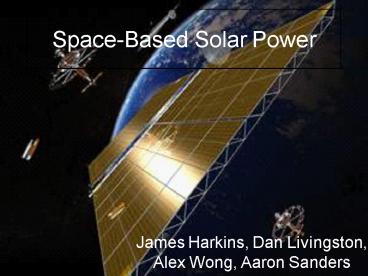SpaceBased Solar Power - PowerPoint PPT Presentation
1 / 16
Title:
SpaceBased Solar Power
Description:
Solar panels on satellite capture light, sends power to earth using microwave ... Solar panels do not take up land on Earth. Lots of space in space ... – PowerPoint PPT presentation
Number of Views:485
Avg rating:3.0/5.0
Title: SpaceBased Solar Power
1
Space-Based Solar Power
- James Harkins, Dan Livingston, Alex Wong, Aaron
Sanders
2
How it works
- Solar panels on satellite capture light, sends
power to earth using microwave wireless power
transmission technology
Signal sent from receiving antenna on earth
(green) allows satellite to pinpoint its
microwave beam.
3
History
- Producing electricity in space from sunlight is
used by hundreds of satellites in operation
today. - In 1968, Dr. Peter Glaser, formerly of NASA,
introduced the concept of a solar power satellite
system with square miles of solar collectors in
high geosynchronous orbit to collect and convert
the sun's energy into a microwave beam to
transmit energy to large receiving antennas
(rectennas) on earth. - In 1999 NASA formed SERT, the Space Solar Power
Exploratory Research and Technology program to
perform design studies and evaluate feasibility.
4
Design Ideas
- Thrusters must be used to counteract solar winds
- The space-based antenna needs to be at least 1 km
in diameter, making it far larger than any
satellite ever proposed. - Recieveing antenna (an array of wires) must cover
20,000 acres. - Sidebands not worth capturing
- Laser alternative to microwave power transmission.
Sage-Hall Thrusters
5
Technology obstacles to overcome
- NASA estimates a SSP will need to operate
at 1000v or higher, which leads to
self-destructive arcing. Current
experimentation is at 300 v. - Wireless power transmission only
recently became a reality, with
small amounts of power over a few
feet. - Lots of design work left regarding the high
temperature characteristics of the transmitting
antenna and the solar array.
Example of self destructive arcing
Image http//gltrs.grc.nasa.gov/reports/2000/TM
-2000-210210.pdf
6
Solar Arrays
- Weight between 0.5 kg/kW to 10 kg/kW
- Lifespan is about 20 years
- Exposure to charged particles can reduce the
lifespan drastically - Naturally degrades about 1 to 2 percent per year
- Efficiency up to 30
- Solar radiation is 5-10 times greater in space
7
Power
- Efficiency of power transmission is about 50
- Microwave transmission will diffract greatly
- Total efficiency is about 7
- Power yield from rectenna is about 90 W/m2
- Lasers are an alternative to microwaves
- Rectenna will only need to be 180m in diameter
8
Benefits of SSP
9
General Benefits
- No pollution after construction
- No ghg during power generation
- Source of energy is free
- Large amount of energy potential.
10
Space Advantages
- Less atmosphere for sunlight to penetrate for
more power per unit area - Any location on Earth can receive power
- Satellite can provide power up to 96 of the time
- Solar panels do not take up land on Earth
- Lots of space in space
- Promote growth of space, solar, and power
transmission technology
11
Problems with SSP
- VERY expensive initial cost
- Microwave/lasers may be harmful?
- Cosmic rays can deteriorate panels
- Maintenance Problems
- Very large receiving antennas on earth
- Solar winds could kick it off course
- Would need a complex propulsion system
12
VERY Expensive Initial Costs
- Cost of Lifting Cargo Into Space using Space
Shuttle is currently 10000/kg - Reusable Launch Systems looking to reduce this
cost are underdeveloped - Space Elevator
13
Microwave Concerns
?
- At the earth's surface, the microwave beam has a
maximum intensity in the center of 23 mW/cm2
(less than l/4 the solar constant) and an
intensity of less than 1 mW/cm2 outside of the
rectenna fenceline - Retrodirective phased array antenna/rectenna
http//ntrs.nasa.gov/archive/nasa/casi.ntrs.nasa.g
ov/19800022396_1980022396.pdf
14
Very large antennas/rectennas
- The distance between the antenna and rectenna
will be roughly the distance from Earth to
geosynchronous orbit (22,300 miles) - For best efficiency the satellite antenna must be
circular between 1 and 1.5 kilometers in diameter - The ground rectenna would need to be elliptical
and around 14 kilometers by 10 kilometers
http//ntrs.nasa.gov/archive/nasa/casi.ntrs.nasa.g
ov/19800022396_1980022396.pdf
15
Very large antennas/rectennas (cont.)
- Anything smaller would result in excessive
losses due to sidelobes. - To collect and convert the
desired energy the satellite would
need between 50 and 100 square
kilometers of collector area using
standard 14 efficient monocrystalline silicon
solar cells making this much larger than most
man-made structures on Earth. - Though not unfeasible, such an enormous
undertaking in orbit has never been attempted - image http//www.spacefuture.com/archive/concept
ual_study_of_a_solar_power_satellite_sps_2000.shtm
l
Microwave power distribution on the ground
surface.
16
Targets
- Launch costs
- Currently 10,000/kg
- Not feasible with chemical rocket technology
- Space elevator
- SSP array costs
- Must be very efficient
- Currently 2.4 million/kW
- Ground-based 5,000/kW
- Operation and Maintenance































